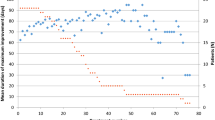Abstract
Segmental craniocervical dystonia is characterized by blephalospasm and oromandibular dystonia and is also called Meige syndrome. The current treatment strategy including botulinum toxin (BTX) injections has not yet attained an acceptable level. We describe a long-term favorable response of a novel combination therapy with aripiprazole (ARP), trihexyphenidyl (THP), and BTX in three patients with segmental craniocervical dystonia. The symptoms of three patients responded promptly to the combination therapy with ARP 3–6 mg daily, THP 2–8 mg daily, and BTX. Although the patients were required to receive a BTX 50–100 IU injection every 3–6 months, their symptoms were kept in a satisfactory condition for up to 2 years without any adverse effects. ARP possesses the potential for dramatically improving dystonia. THP has the possibility to enhance the efficacy of ARP and prolong the effective period of BTX. It may be an important requisite to give all three agents together for a successful treatment. The combination therapy with ARP, THP, and BTX was well-tolerated and useful in controlling the symptoms of segmental craniocervical dystonia, however, the reason why this combination therapy succeeded is unknown. A further long-term follow-up is required to monitor the delayed neurological adverse effects.
Similar content being viewed by others
References
LeDoux MS (2009) Meige syndrome: what’s in a name? Parkinsonism Relat Disord 15:483–489
Van den Bergh P, Francart J, Mourin S, Kollman P, Laterre EC (1995) Five-year experience in the treatment of focal movement disorders with low-dose dysport botulinum toxin. Muscle Nerve 18:720–729
Potkin SG, Saha AR, Kujawa MJ et al (2003) Aripiprazole, an antipsychotic with a novel mechanism of action, and risperidone vs placebo in patients with schizophrenia and schizoaffective disorder. Arch Gen Psychiatry 60:681–690
DeLong MR, Wichmann T (2007) Circuits and circuit disorders of the basal ganglia. Arch Neurol 64:20–24
Balash Y, Giladi N (2004) Efficacy of pharmacological treatment of dystonia: evidence-based review including meta-analysis of the effect of botulinum toxin and other cure options. Eur J Neurol 11:361–370
Sanghadia M, Pinninti NR (2007) Aripiprazole-associated acute dystonia. J Neuropsychiaty Clin Neurosci 19:89–90
Conflict of interest
None.
Author information
Authors and Affiliations
Corresponding author
Electronic supplementary material
Below is the link to the electronic supplementary material.
10072_2014_1927_MOESM1_ESM.mpg
Video 1: Three months after continuing the administration of THP. THP improved the blepharospasm only minimally; however it did not influence the involuntary spasmodic contractions of the bilateral orbicularis oculi, levator labii superioris, and platysma. The leftward lingual deviation and cervical rotation also remained the same (MPG 2928 kb)
10072_2014_1927_MOESM2_ESM.mpg
Video 2: Nine months after continuing the administration of THP and 6 months after the first subcutaneous injection of BTX. Note that his blepharospasm almost disappeared. Also the movements such as the compression and sideward drawing of his lips resolved, however, it resulted in the obtrusiveness of the continuous leftward lingual deviation and mastication-like movements (MPG 1244 kb)
10072_2014_1927_MOESM3_ESM.mpg
Video 3: Ten months after continuing the administration of THP, 7 weeks after starting the ARP, and 3 weeks after the second injection of BTX. His residual spasmodic lingual deviation to the left and mastication-like movements were remarkably improved (MPG 2140 kb)
Rights and permissions
About this article
Cite this article
Saito, T., Katayama, T., Sawada, J. et al. Combination therapy for segmental craniocervical dystonia (Meige syndrome) with aripiprazole, trihexyphenidyl, and botulinum toxin: three cases reports. Neurol Sci 36, 243–245 (2015). https://doi.org/10.1007/s10072-014-1927-x
Received:
Accepted:
Published:
Issue Date:
DOI: https://doi.org/10.1007/s10072-014-1927-x




